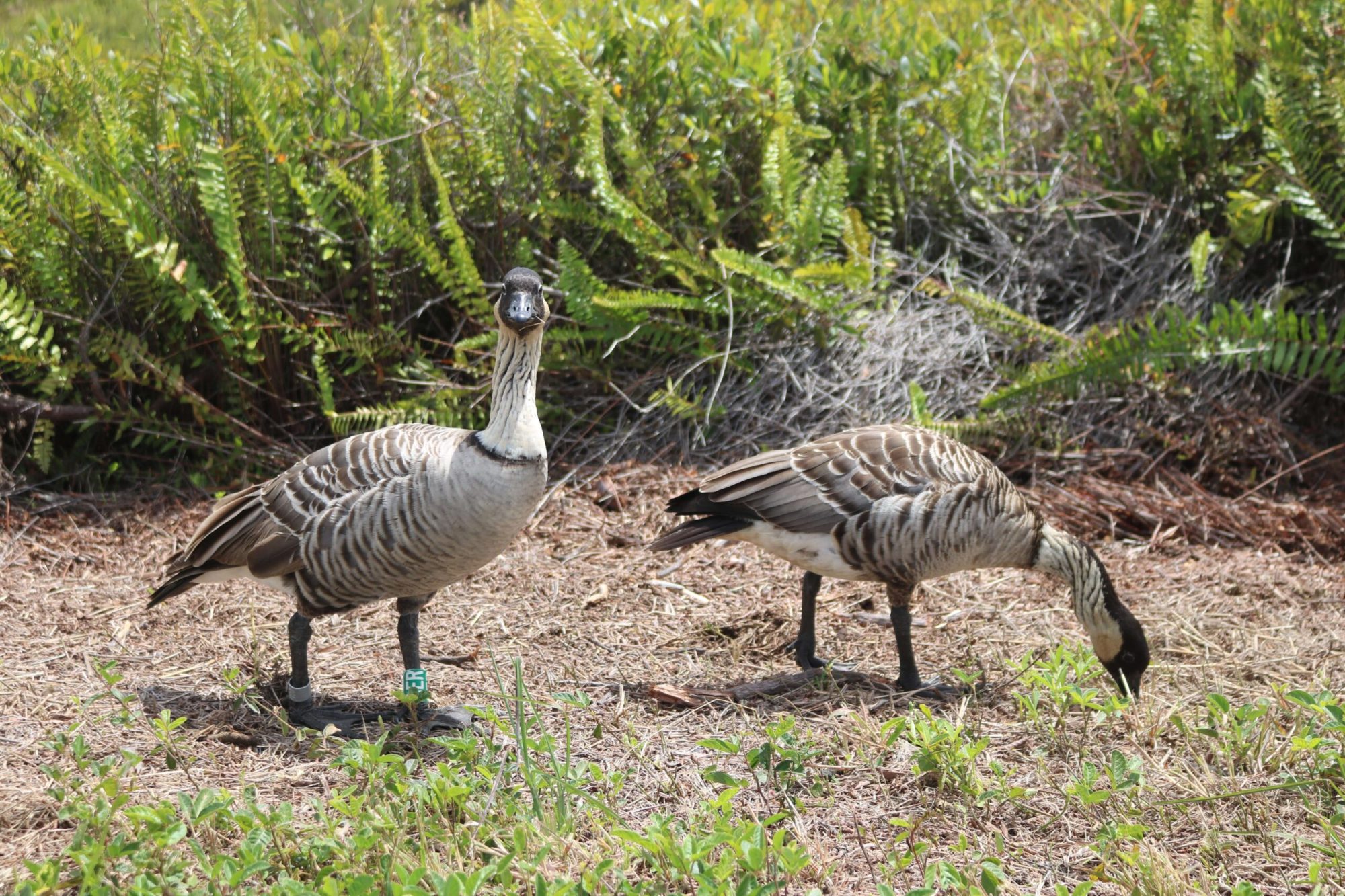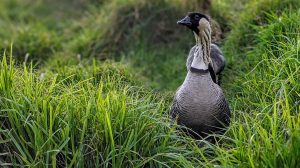Hawaii’s State Bird – The Nene Goose

The Nene Goose, known as Hawaii’s state bird, holds a special place in the island’s unique ecosystem and cultural heritage. From a rich conservation history to its current status in Hawaii, the Nene Goose is nothing short of a great comeback story.
Our post explores the fascinating characteristics, conservation efforts, and significance of the Nene Goose. Learn everything about this amazing animal and join us as we delve into the world of this remarkable bird and discover why it deserves our attention and protection.
Overview Of The Nene Goose
The Nene Goose (Branta sandvicensis), also called the Hawaiian Goose, is a species of goose endemic to the Hawaiian Islands. It is the world’s rarest goose and has held the honor of being Hawaii’s state bird since 1959.
Historically, the Nene Goose thrived on the islands, inhabiting a variety of habitats, including grasslands and shrublands. The Nene Goose is the only living native goose species located in the Hawaiian Islands, making it a rare and important animal to the islands.
Why is the Nene Goose so rare?
The Nene Goose’s rarity is a result of historical hunting practices and the introduction of non-native predators to the Hawaiian Islands.
These factors led to a severe decline in their population, with only 30 individuals remaining in 1967, bringing them to the brink of extinction. The impact of these threats highlights the urgent need for conservation efforts to protect and revive this endangered species.
Conservation Status Of The Nene Goose
Despite once being abundant, the Nene Goose faced a severe decline in population due to various factors. Habitat loss, predation by introduced species, hunting, and collisions with vehicles have all contributed to the decline of this species.
Recognizing the critical situation, conservation efforts were initiated to protect and revive the Nene Goose population. These efforts included habitat restoration, captive breeding programs, and the establishment of protected areas.
The Nene Goose population gradually began to recover, and as of the latest census, the population has increased to approximately 3,800 individuals, with a majority of them estimated to be on Kauai. Kauai has always been home to a diverse population of birds.
What Hawaiian Island has the most Nene Geese?
Kauai is estimated to have the highest population of Nene Geese, with the U.S. Fish and Wildlife Service estimating around 2,500 of the existing 3,862 being on the island of Kauai.
What The Nene Goose Looks Like
The Nene Goose is a medium-sized bird, measuring around 20-25 inches in length and weighing between 2-6 pounds. It has a distinctive appearance, with a short black bill, gray-brown plumage, and black feet.
Unlike most geese, the Nene Goose lacks webbed feet, as it has adapted to life in volcanic areas where it feeds on grasses and other vegetation.

Why The Nene Goose Is Significant In Hawaiian Culture
The Nene Goose’s role as the state bird symbolizes the connection between the people of Hawaii and their unique environment. It serves as a cultural ambassador, representing the natural heritage of the islands and inspiring a sense of pride and responsibility in preserving their natural resources.
As one of the rarest species in the world and one of the few native species still left on the Hawaiian Islands, the Nene Goose is an important symbol of nature and the unique ecosystems the islands are home to.
The Environmental Importance Of The Nene Goose
As a native species, the Nene Goose plays a vital role in the Hawaiian ecosystem. By feeding on grasses and other vegetation, the Nene helps control plant growth and maintains the balance of its habitat. Additionally, their excrement serves as fertilizer, promoting the growth of native plants.
The Nene’s foraging habits also aid in seed dispersal, contributing to the regeneration of plant species across different areas. By participating in the natural processes of the ecosystem, the Nene Goose supports biodiversity and helps maintain the overall health of Hawaii’s native habitats.
How To See The Nene Goose In Hawaii
Visitors to Hawaii have the unique opportunity to encounter the Nene Goose in its natural habitat. National parks and wildlife refuges, such as Haleakalā National Park and Hawai’i Volcanoes National Park, provide protected areas where visitors can observe these remarkable birds.
It is important to remember that the Nene is a protected species, and responsible behavior, such as maintaining a safe distance and not feeding them, is crucial.
Educational programs and guided tours offer insights into the conservation efforts and challenges faced by the Nene Goose. These experiences provide an opportunity to learn about the bird’s history, its importance to Hawaiian culture, and the ongoing initiatives to protect and preserve this endangered species.
Where does the Hawaiian Goose mainly live now?
The Hawaiian Goose is primarily found on the islands of Hawaii, Kauai, Maui, and Molokai. These islands have been the main strongholds for the Nene population. However, in recent years, efforts to reintroduce the Nene Goose to suitable habitats have resulted in sightings on the island of Oahu as well.
What type of habitats can the Hawaiian Goose be found in?
The Hawaiin Goose can be found in a wide range of habitats across the Hawaiian Islands. They are commonly observed in grasslands and shrublands, where they forage on grasses and other vegetation.
Remarkably, they have also adapted to volcanic deserts, navigating through high-elevation lava flows with their specialized feet.
Nene Geese are even seen in unexpected locations, including golf courses. Their presence on these greens not only adds a touch of natural beauty but also serves as a reminder of the importance of preserving and protecting the habitats that these remarkable birds call home.
Facts About The Nene Goose
- The Nene Goose is currently the rarest goose in the world.
- The word “nene” in Hawaiian means a “soft call,” referring to the sounds the Hawaiian Goose makes.
- Based on DNA, the Hawaiian Goose is very closely related to the Canadian Goose.
- The Nene Goose was designated Hawaii’s state bird in 1957
The Importance Of Hawaii’s State Bird
Not only is the Nene Goose an important part of Kauai & Hawaii’s wildlife populations, but it also represents the importance of conservation and protecting the delicate ecosystems that exist in the Hawaiian Islands.
Through successful initiatives, this rare bird has made a remarkable recovery. By raising awareness about the Nene Goose and supporting ongoing conservation endeavors, we can help ensure the survival of this iconic species for generations to come.
Visit Hawaii & See The Nene Goose!
From the brink of extinction, this remarkable species has made a remarkable comeback, thanks to the dedication of conservation organizations, researchers, and passionate individuals.
The Nene Goose symbolizes the fragile beauty of the Hawaiian Islands and serves as a reminder of our responsibility to protect and preserve the unique biodiversity that thrives here.
By raising awareness, supporting conservation initiatives, and fostering a sense of stewardship, we can ensure a bright future for the Nene Goose and the enchanting landscapes they call home.
Join us at Kauai Sea Tours!
If you’re seeking an unforgettable experience with Hawaii’s natural wonders, look no further than Kauai Sea Tours! With our deep appreciation for the islands’ wildlife and commitment to sustainable tourism, we at Kauai Sea Tours offer unique opportunities to explore the pristine beauty of Hawaii.
Embark on a guided tour or cruise with Kauai Sea Tours, and immerse yourself in the captivating world of Kauai and witness other awe-inspiring creatures that make the Hawaiian Islands truly extraordinary.

